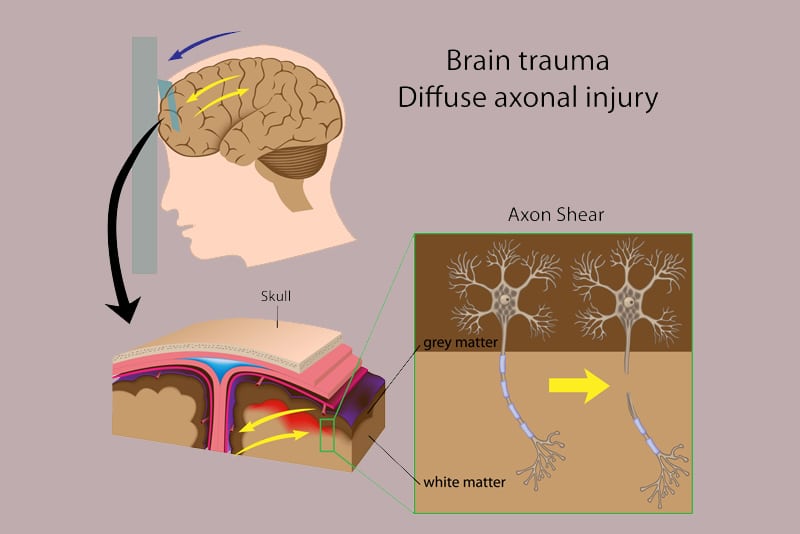Traumatic brain injury (TBI) occurs when a sudden, external force damages the brain. One of the most common causes of disability and death in adults under the age of 40 years, TBI is a broad term that describes a vast spectrum of injuries that happen to the brain. The damage from an external force can be either focal (confined to one single area of the brain) or diffuse (occurs in more than one area of the brain). The severity of a brain injury can range from a mild concussion to a serious injury that lead to coma or even death. Diffuse axonal injury (DAI) is one of the most common types of traumatic brain injury that occurs when the brain rapidly shifts inside the skull. In simple terms, it is the tearing (shearing) of the brain’s long connecting nerve fibers (axons) when the brain rapidly accelerates and decelerates inside the hard bone of the skull. These forces result in gross damage to the axons (white matter of the brain) – the parts of neuron cells that transmit information within the nervous system. The damage or changes in the brain in most cases may be microscopic and may not be evident on computed tomography (CT scan) or magnetic resonance imaging (MRI) scans. DAI is most common in high energy trauma like high speed motor vehicle accidents or a result of falls, sporting accidents, assaults and child abuse (such as shaken baby syndrome). If not properly diagnosed and treated, this type of injury may lead to severe disruption in nerve communication – affecting a person’s physical, cognitive, emotional and behavioral impairments thereby leading to a loss of functional independence. Neurosurgeons or neurology specialists who provide appropriate treatment for this type of traumatic brain injury need to ensure that the billing and coding for this condition is properly done on the medical claims. A reliable medical billing company can ensure accurate documentation and reimbursement.
Common Symptoms of DAI
Loss of consciousness is one of the most prevailing symptoms of DAI, which typically lasts for six or more hours. The type and severity of symptoms can vary and depend on the extent of brain damage. If the nature of injury is mild, then people may remain conscious but display other signs of brain damage like fatigue, trouble sleeping, difficulty concentrating and headaches, which may vary and depend upon which area of the brain has been damaged. Moderate to severe injuries may have physical symptoms like weakness, hypertonia, balance problems and reduced coordination. Cognitive deficits like memory problems, lack of attention, and difficulty in processing information can also lead to problems with mood and behavior. In more severe cases, patients may remain in coma for a prolonged period of time. Other symptoms include –
- Disorientation or confusion
- Dizziness
- Drowsiness or fatigue
- Inability to understand abstract concepts
- Loss of sense of time and space
- Motor deficits (like paralysis, spasticity, Inability to plan motor movements, delays in getting started, tremors and swallowing problems)
- Nausea or vomiting
- Perceptual or sensory deficits (like changes in hearing, vision, taste, smell, and touch, loss of sensation or heightened sensation of body parts and vision problems)
- Problems with judgment
- Problem-solving deficits
- Shortened attention span
- Sleeping longer than normal
- Trouble sleeping
Treatment Options to Reduce the Severity of Brain Injury
Reducing swelling inside the brain is the immediate course of action required in case of a diffuse axonal injury, to prevent further brain damage. In certain cases, a course of steroids will be prescribed by physicians to reduce the amount of swelling. Treating patients who have suffered the devastating effects of brain injury involves utilizing the principles of neuroplasticity and motor learning to optimize client recovery.
There is no specific surgery to treat people who have sustained a DAI. If the intensity of injury is severe, there is a likelihood of a vegetative state or even death. On the other hand, if the DAI is mild to moderate, there are chances of rehabilitation. Rehabilitation or recovery programs include – gait training, postural control and balance training, physical therapy, speech therapy, improving muscle performance, increasing sensory awareness, aerobic training and improving joint mobility, adaptive equipment training and counseling.
Neurosurgery medical coding involves using the specific ICD-10 diagnosis codes to report DAI on the medical claims they submit to health insurers for reimbursement. ICD-10 diagnosis codes for diffuse axonal injury include –
-
- S06.2 Diffuse traumatic brain injury
- S06.2X Diffuse traumatic brain injury
- S06.2X0 Diffuse traumatic brain injury without loss of consciousness
- S06.2X0A …… initial encounter
- S06.2X0D …… subsequent encounter
- S06.2X0S …… sequela
- S06.2X1 Diffuse traumatic brain injury with loss of consciousness of 30 minutes or less
- S06.2X1A …… initial encounter
- S06.2X1D …… subsequent encounter
- S06.2X1S …… sequela
- S06.2X2 Diffuse traumatic brain injury with loss of consciousness of 31 minutes to 59 minutes
- S06.2X2A …… initial encounter
- S06.2X2D …… subsequent encounter
- S06.2X2S …… sequela
- S06.2X3 Diffuse traumatic brain injury with loss of consciousness of 1 hour to 5 hours 59 minutes
- S06.2X3A …… initial encounter
- S06.2X3D …… subsequent encounter
- S06.2X3S …… sequela
- S06.2X4 Diffuse traumatic brain injury with loss of consciousness of 6 hours to 24 hours
- S06.2X4A …… initial encounter
- S06.2X4D …… subsequent encounter
- S06.2X4S …… sequela
- S06.2X5 Diffuse traumatic brain injury with loss of consciousness greater than 24 hours with return to pre-existing conscious levels
- S06.2X5A …… initial encounter
- S06.2X5D …… subsequent encounter
- S06.2X5S …… sequela
- S06.2X6 Diffuse traumatic brain injury with loss of consciousness greater than 24 hours without return to pre-existing conscious level with patient surviving
- S06.2X6A …… initial encounter
- S06.2X6D …… subsequent encounter
- S06.2X6S …… sequela
- S06.2X7 Diffuse traumatic brain injury with loss of consciousness of any duration with death due to brain injury prior to regaining consciousness
- S06.2X7A …… initial encounter
- S06.2X8 Diffuse traumatic brain injury with loss of consciousness of any duration with death due to other cause prior to regaining consciousness
- S06.2X8A …… initial encounter
- S06.2X9 Diffuse traumatic brain injury with loss of consciousness of unspecified duration
- S06.2X9A …… initial encounter
- S06.2X9D …… subsequent encounter
- S06.2X9S …… sequela
There are differing levels of severity of DAI, with concussion being considered one of the milder forms. Complete recovery is possible in very mild cases. People with severe head injuries may not survive. People who happen to survive with these injuries are often left unconscious or never ever regain consciousness. If people recover or gain consciousness, intensive rehabilitation will be needed or else they will be left with long-term problems even after rehabilitation.
Medical billing and coding for traumatic brain injuries like DAI can be complex. By utilizing outsourced medical billing services provided by a reliable medical billing and coding company, healthcare practices can ensure correct and timely medical billing and claims submission.




